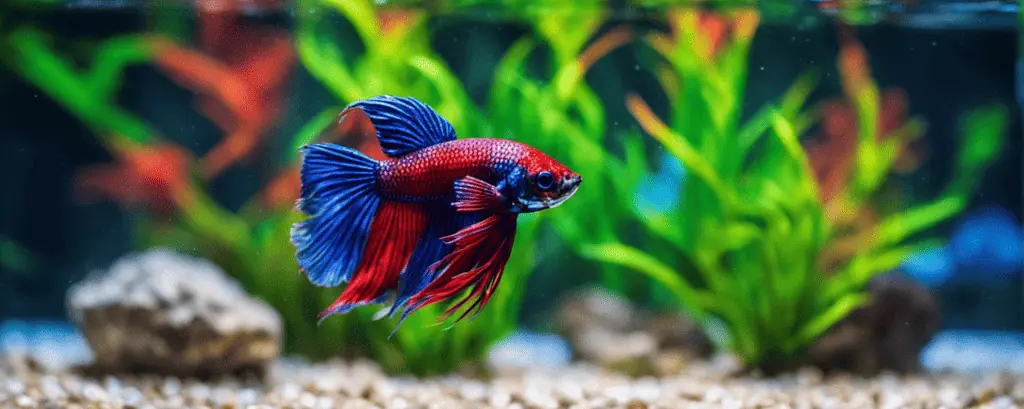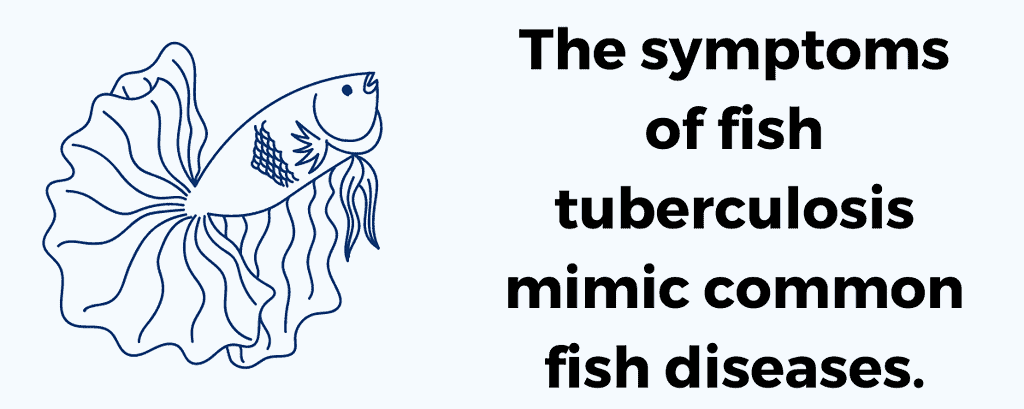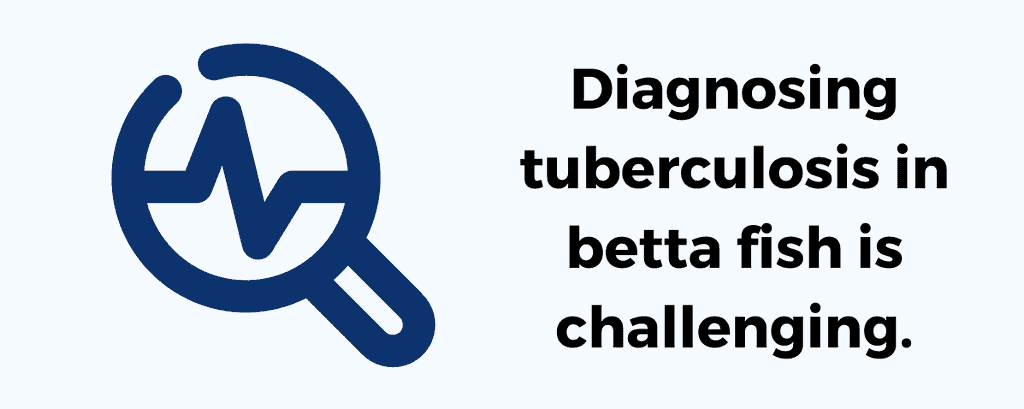Tuberculosis is a rare but deadly disease for betta fish.
The disease is slow-moving and takes up to six months before symptoms appear. When your betta shows symptoms, its internal organs are already shutting down.
Bettas contract tuberculosis from mycobacterium found in many fish tanks.
Healthy bettas are less susceptible to tuberculosis than those with lowered immune systems.
Diagnosing tuberculosis is difficult because the symptoms mimic other common betta diseases.
There is no cure for the advanced stages of betta tuberculosis. If you catch the disease early, treatment options only manage the symptoms.

Table of Contents
What Causes Betta Fish Tuberculosis?

Tuberculosis spreads through a common mycobacterium known as Mycobacterium Marinum. This mycobacterium is present in many aquariums and does not affect healthy fish.
The mycobacterium may stay in a betta’s body for up to six months.
Once the betta’s immune system becomes compromised, the disease attacks the liver and kidneys. Tuberculosis eventually causes organ failure, leading to death.
There are several ways a betta may contract tuberculosis.
Bacterial Infection

Mycobacterium may enter a betta’s body through an open wound.
Any time a betta has an injury causing a cut or lesion, the fish is more susceptible to bacterial infection.
Injuries and other illnesses also lower a betta’s immune system.
This is the perfect time for the mycobacterium to attack the betta’s internal organs.
Transmission From Other Infected Fish

Fish tuberculosis may stay dormant in the body for up to six months before symptoms begin.
This makes it difficult when adding new tank mates.
The usual quarantine period of 4-6 weeks is not long enough for potential symptoms of tuberculosis to show.
A fish may be infected with tuberculosis and added to your betta tank without you ever knowing.
Simple stress from a new tank mate could make your betta prone to the disease.
Tuberculosis is highly contagious. It only takes one infected fish to infect the entire tank.
Whenever you suspect a fish is ill, you must move them to a separate quarantine tank. Proper quarantine protocols prevent diseases from spreading to other fish.
Poor Water Quality and Living Conditions

Poor water conditions are a breeding ground for various bacteria and toxins.
High ammonia levels lower a betta’s immune system.
A dirty environment also causes stress in bettas. Prolonged stress makes a betta prone to illness.
Fluctuating temperatures and pH levels are not good for a betta’s health, either.
Sudden temperature changes may cause temperature shock in betta fish.
Infected Live Foods

Live foods add variety and nutrition to a betta’s diet.
But, if the live foods carry tuberculosis, they can pass the disease to your betta.
Bettas may also contract tuberculosis from eating another infected fish.
Improper Breeding Practices

Poor breeding methods create betta fish with weakened immune responses.
This includes breeding fish in contaminated water or producing bettas with genetic mutations.
These bettas have a lifelong susceptibility to diseases due to lower immune response. Their bodies are less likely to fight off an invasion of mycobacterium.
7 Common Symptoms of Betta Fish Tuberculosis

The symptoms of fish tuberculosis are like those of many common fish diseases.
This creates a very dangerous situation for bettas suffering from tuberculosis.
When tuberculosis symptoms appear, the betta may already have internal organ failure.
Do not panic right away if your betta has any of these symptoms.
Tuberculosis in bettas is rare, and these symptoms could indicate a less severe disease.
1. Loss of Appetite

Loss of appetite is a classic symptom of most betta fish diseases.
Bettas with a tuberculosis infection refuse to eat at all and become anorexic.
Muscle wasting is also common with this disease.
2. Weight Loss

Since a betta with tuberculosis refuses food, it loses weight.
After a short time, the betta develops an emaciated appearance.
If the betta does not receive vital nutrients, its health deteriorates.
3. Fatigue and Lethargy

A lack of nutrients depletes a betta’s energy.
The emaciated fish may sleep a lot during the day and move sluggishly.
Your betta may float to the tank’s top because it can no longer swim.
4. Swelling or Lumps on the Body

A betta suffering from tuberculosis has visible skin defects, including:
- Skin lesions
- Wasting of flesh
- Open wounds
- Blood spots
- Granulomas
These areas of inflammation may appear anywhere on the body.
The appearance of persistent skin infections is usually confused with other betta diseases like columnaris or furunculosis.
5. Discoloration of Scales and Fins

Scale and fin damage are also symptoms of tuberculosis.
Issues like black scales or loss of scales are common with this disease.
Sometimes the scales have a pinecone appearance, and the tuberculosis is mistaken for Dropsy.
Folded fins are also a symptom of tuberculosis. This symptom has a similar appearance to fin and tail rot.
6. Curved Spine

A curved spine is the result of organ failure caused by tuberculosis.
Unlike dropsy, tuberculosis makes the spine curve vertically instead of side to side.
This symptom is irreversible and very painful for the betta fish.
7. Eye Damage

Tuberculosis may cause protrusion or discoloration of the betta’s eyes.
This happens because swollen organs push the betta’s eyes outward.
If you have treated your betta with antibiotics for popeye with no results, tuberculosis is likely the cause.
How Do You Diagnose and Treat Tuberculosis in Betta Fish?

Diagnosing tuberculosis in betta fish is challenging.
Symptoms of tuberculosis are vague and usually mistaken for other common fish diseases.
Only a veterinarian can determine whether your betta’s illness is actually tuberculosis.
Diagnosing Tuberculosis in Betta Fish

There are currently no tests for mycobacterium in live fish.
A veterinarian must perform a biopsy of the betta’s internal organs. Unfortunately, this is only possible after the fish has died.
The biopsy is sent to an aquatic pathologist. An acid stain test confirms the presence of mycobacterium.
Internal organs from a betta with tuberculosis also have white or gray bumps.
The veterinarian can only guess at a tuberculosis diagnosis if treatments for other betta diseases fail.
The bad news is tuberculosis has already affected the internal organs by this time.
Treatment Options for Tuberculosis in Betta Fish

There is no cure for tuberculosis in betta fish.
Treatment options only exist for managing the symptoms in the early stages of the disease.
Traditional treatment methods like increasing tank temperatures or aquarium salt do not work with mycobacterium.
Using these methods can make the disease spread faster.
Mycobacterium Marinus thrives in higher temperatures. Aquarium salt is not an effective treatment for tuberculosis symptoms.
You may prolong your betta’s life and relieve some symptoms with the following treatment plan:
- Move your betta to a quarantine tank when symptoms first appear. This prevents the disease from spreading to other tank mates.
- Place an air stone and a gentle filter from a cycled tank into the quarantine tank. Avoid activated carbon because it absorbs the medication.
- Add the antibiotics prescribed by your veterinarian into the quarantine tank.
- Give your betta a methylene blue bath. Methylene blue helps control mild fungal infections and parasites.
Your veterinarian may also prescribe an appetite stimulant if your betta is not eating.
This treatment plan may not work if your betta is in the advanced stages of organ failure.
The only available option is humanely euthanizing your betta.
Preventing Re-Infection

After confirming your betta has tuberculosis, you must sanitize the original tank before adding any more fish.
Mycobacterium Marinum contaminates everything in the aquarium environment. This includes tank equipment like the filter and heater.
You must throw away plants, driftwood, and other porous materials. Once the mycobacterium infects porous surfaces, they cannot be cleaned properly.
Only use cleaners approved by your veterinarian. Chemical residues on aquarium equipment are harmful to fish and live plants.
5 Ways To Prevent Tuberculosis in Betta Fish

Tuberculosis is rare in bettas, especially if you follow good fishkeeping practices.
Purchasing your betta from a reputable source prevents getting an infected fish.
Following a few simple steps ensures your betta stays healthy.
1. Regularly Check for Symptoms
Check your betta often for changes in its appearance or behavior, such as:
- Discoloration/white spots
- Body lesions/wounds
- Ragged fins
- Bloating
- Weight loss
- Lethargy
- Loss of appetite
- Erratic swimming
Treating diseases when symptoms first appear ensures your betta makes a full recovery. Diseases like fin and tail rot start small but can spread to the body without prompt treatment.
When illnesses reach advanced stages, treatment becomes challenging.
If you are unsure what is wrong with your betta, consult a veterinarian.
Sick bettas also have a lowered immune response against other diseases and parasites.
2. Clean and Maintain the Fish Tank
Ideal Water Parameters for a Betta Fish Tank Include the following:
- Temperature: 78-80° degrees Fahrenheit (25.5-27° C)
- pH: 6.5-7.5
- Ammonia and Nitrite: 0 ppm
- Nitrate: < 40 ppm
- gH: 3-4 dGH (50-66.7 ppm)
- kH: 3-5 dKH (53.6-89.4 ppm)
- Minimum Tank Size: 5 Gallons
Establish a regular maintenance routine for your betta tank.
Poor water conditions cause stress and make your betta prone to illness.
Perform a regular water change every week.
Only remove and replace 20 percent of the aquarium water. This avoids disturbing your tank parameters.
Regularly test your water parameters for pH and toxin levels. High ammonia levels cause chemical burns on bettas.
Maintain steady water temperatures with an aquarium heater. Sudden fluctuations in water temperatures may cause temperature shock.
Control ammonia and bacteria levels by investing in a quality sponge filter. Sponge filters create a gentle current and do not interfere with your betta’s swimming abilities.
A gravel vacuum removes fish waste and leftover food from the substrate. This prevents harmful bacteria from forming.
Remove algae from the sides of the tank with an algae scraper. You may also add algae eaters like snails and shrimp for this job.
3. Quarantine New Fish

Quarantine new tank mates for 4-6 weeks before adding them to your betta tank.
Proper quarantine protocols ensure the new additions do not bring contagious diseases to the main tank.
It is difficult to know if the new fish have tuberculosis unless they already show symptoms. But, the stress of the move may be enough to trigger the disease.
If the fish stay healthy throughout quarantine, they likely do not have tuberculosis.
In the event the new fish become ill during quarantine, consider returning them.
Purchasing your fish from a reputable source decreases the risk of tuberculosis or other diseases.
4. Avoid Overcrowding in the Tank

Overcrowding a community tank increases the chance of mycobacterium formation.
The bioload from too many fish in a small tank may be too much for your filter.
Tank maintenance becomes more difficult and there is an increased risk of disease.
A 10-gallon tank works well for a betta and a couple of snails or shrimp.
For larger species, I recommend at least a 20-gallon tank.
Bettas are very territorial and get stressed when they have no space in the aquarium.
Live plants and hiding spots also create a less stressful natural environment.
5. Buy Live Food from Reputable Sources

Live foods add variety and extra nutrition to your betta’s diet. But there is a higher risk of parasites, especially with blood worms.
Vinegar eels and micro worms are safer options because they do not carry tuberculosis.
Always buy live food from reputable sources. This lowers the chance of introducing tuberculosis or parasites into your betta tank.
Other options for a varied diet include frozen or freeze-dried foods.
Parasites do not survive the freezing or freeze-drying processes.
Frozen foods are a bit messy because you must thaw them in a separate cup of tank water. But some of their nutrients remain intact.
Freeze-dried foods are less of a hassle, but the freeze-drying process destroys many of their nutrients.
Soak freeze-dried foods before feeding them to your betta to prevent constipation.
Can You Get Tuberculosis From Your Betta?

Humans can contract fish tuberculosis through open cuts or sores.
Fish tuberculosis is not a death sentence for humans but can cause persistent skin infections.
People with compromised immune systems have a higher risk of getting fish tuberculosis.
Avoid contracting the disease by wearing gloves when putting your hands in your betta tank.
Wash your hands any time you come into contact with aquarium water.
Never put your mouth on a siphon when performing a water change. Let gravity do the work.
Lowering the Risk of Betta Fish Tuberculosis
Betta fish tuberculosis is a rare disease with severe consequences.
There is no cure for fish tuberculosis, and treatment only manages the symptoms.
Early diagnosis is impossible, so prevention is crucial.
Regular tank maintenance and proper care for your betta keep the disease from developing.
Protect yourself from fish tuberculosis by wearing gloves and practicing good hygiene when you clean your betta tank.
For help keeping the betta tank clean and preventing disease, check out our guide at the link.


